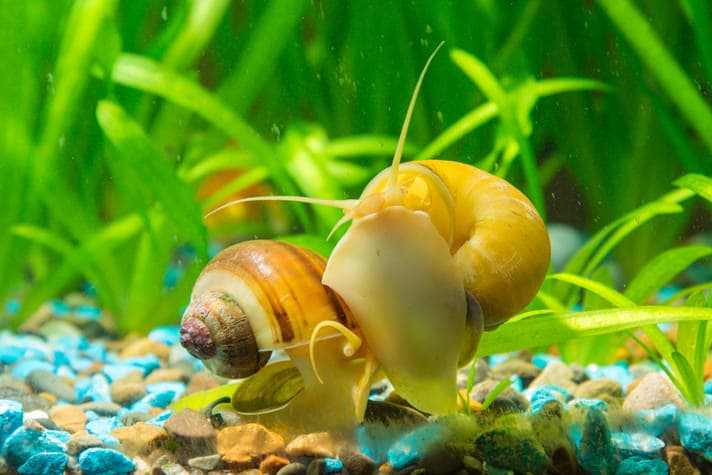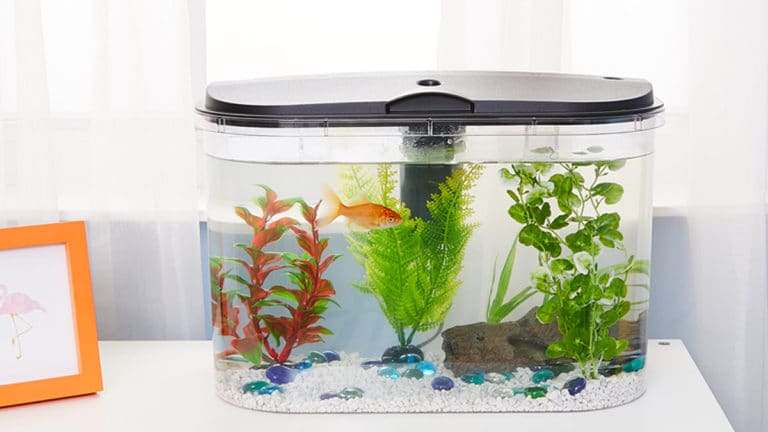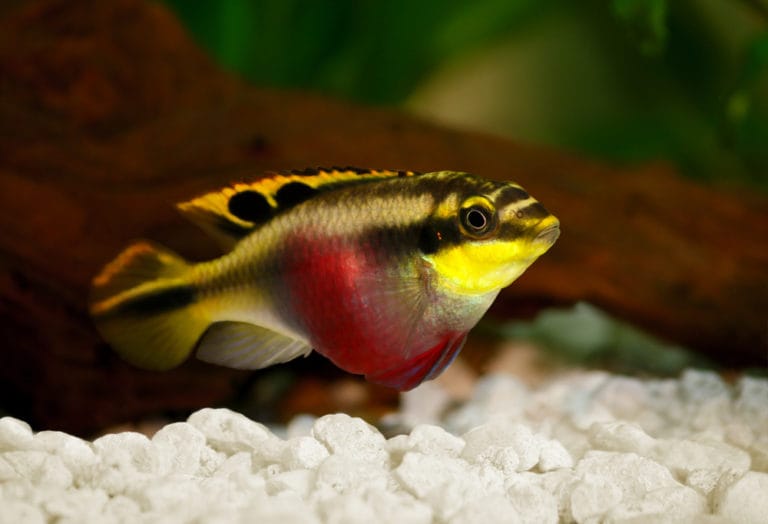The symbiosis between gobies and pistol shrimp is one of the many that can occur in our marine aquariums. In the goby and pistol shrimp symbiosis, both animals benefit. This relationship is not parasitic and not commensal—it is mutual. The shrimp builds and maintains a burrow that both animals live in, and the fish offers the shrimp protection from predators. When they are outside of the burrow, the fish keeps an eye out for predators and warns the goby with a flick of the tail if there is a predator nearby. The nearly blind shrimp can then retreat into the burrow to be spared from predation. These animals participate with each other on a highly elaborate and evolved level—and it becomes more impressive when you think about how they are in no way related.
This is an amazing partnership, but what goes on inside of the burrow that they both inhabit? Until recently, we have only been able to observe their behavior outside of their elaborate burrows. I have been able to make some new observations with an interesting tank setup. First I will tell you the history of studying this particular symbiosis, then I will let you know how you can set up a tank specifically for viewing this symbiosis, and then I will relate my new findings.
A Scientific History
Luther, when he was a junior scientist, managed to catch a goby and pistol shrimp pair and put them in a small fish aquarium after they had been discovered during a 1957 expedition of the Red Sea. There he found out that the association was definitely there and it hadn’t been just a random observation in the field. When put in the little tank, the animals still kept contact with each other and soon started to build a new home in the tank’s sand. Although this interesting relationship had been discovered, the colorful wonderland of coral reefs to be discovered might have been the reason why the study of their symbiosis was put on hold and not studied again until the 1970s.
Indeed it took a lot of time until these peculiar couples were back in scientific focus. It was again in the Red Sea, and the same species of fish and shrimp that came to the awareness of biologist Ilan Karplus in the 1970s and 1980s. He and his associates studied how these animals communicate, their territorial behavior, the dynamics of building the burrows and the distribution of the different species. Observing them in nature by diving was difficult at best; scientists could lay down in front of the burrow entrances until their air ran out. It took a long time to observe them because any disturbance caused them to stay inside the burrow for hours. Everyone who has tried to take pictures of them in nature is aware of this.
Today we know that the symbiosis between gobies and pistol shrimp is an evolutionary model of success. About 130 species of gobies are associated with about 20 species of pistol shrimp. The majority of these are found in the Indo-Pacific and adjacent regions. There are goby generalists that live together with different shrimp, but there are also specialists living with just one species (Karplus et al., 1981). Species differ concerning the distribution of their partners, their age and sort of substrate (different gobies prefer finer or more coarse sediment). Yanagisawa (1984) studied activity patterns throughout the day. Shrimp leave the burrows only during daylight in company with the gobies. Shrimp or gobies never lived alone in a burrow, and the minimum count was a single shrimp and a single goby. More often, a couple of gobies and a couple of shrimp were found in one burrow.
To observe the association in aquaria was another approach to find out more. Karplus et al. (1972a) experimented with the gobies and pistol shrimp. The partners had to find each other in a Y-shaped testing channel, either by optical or olfactory abilities. The shrimp did not show any optical orientation at all, but the gobies did. Gobies could differentiate potential partner shrimp by sight (Karplus et al., 1981). If unsuitable partners were presented in experiments, the gobies stayed away. In reverse, the shrimp found their partners by smell.
There was interest from the beginning about what the burrow looked like, but all that was visible from outside was the entrance. Karplus et al. (1972b) built an artificial burrow by taking halved plastic tubing and gluing it to the front glass of an aquarium. The tubes were filled with sand before the experiment started. After the shrimp excavated the tubes, the partnership could be viewed. This setup, however, appeared too artificial to me. Yanagisawa (1984) even poured resin into burrow openings in the wild. After the resin hardened, the cast that was dug out showed the burrow’s dimensions. The burrows went down as far as 1.5 feet into the ground. The burrow often divided, and the tunnels extended into chamberlike structures. Larger coral rubble pieces or skeleton parts of sand dollars were integrated into the burrow.
My Observations
These trials to find out more about the burrow system just fueled my interest to find out what was really going on inside. Among marine aquarists, it was not even known that couples of shrimp and couples of gobies naturally live together. Most aquarists were happy to have one shrimp and one goby in their tank combined. Where and how would they reproduce? Existing observation did not have an answer for this question. But how could I look inside the burrow?
I noticed that the shrimp tended to build their burrows along the bottom glass of the tanks. Steady beating of the abdominal appendages (pleopods) kept the bottom glass free of sediment. So I set up a 34-gallon tank on a high rack, enabling me to sit below and to observe them through the bottom glass of the tank. The tank’s bottom needed to be thick enough to be unsupported from below. The frame of the rack just held the tank around its circumference. To reduce any potential negative impact from light below, I covered my observation chamber with a black curtain. I took videos or pictures with just a little light that I could switch on.
I chose the often-imported Cryptocentrus cinctus and Alpheus bellulus to put in the observation tank. Both species were caught and imported in larger numbers together from Sri Lanka. Amalgamating the couples of fish and shrimp was not an easy task. If same sexes are in a small tank, it often ends in severe trouble—the shrimp are able to kill each other in an aquarium. Therefore I kept them as far apart as possible in separate tanks until I could identify the sexes of the shrimp (female shrimp have a more broad abdomen and more broad pleopods). I also kept the young gobies separated. By changing the partners in one tank, I could easily find out if two specimens would go together, which is the indication for different sexes.
In the next step, I brought both couples together in the observation tank. I kept the interior of the tank simple: just a 2- to 2.4-inch-deep layer of mixed coral sand and gravel, and two pieces of flat live rock. The shrimp started building the burrow immediately after I introduced them in a little cup and directed them into a gap I made under a piece of live rock. Then the fish were added. It did not take longer than an hour, and the double couple was together.
During the next days, the burrow grew. The shrimp transported all excavated material and pushed it outside the burrow. They used their claws to push the sand like a little bulldozer. They do construction work to increase the burrow’s entrance stability, or they use their legs to throw sediment backward. This astonishing skill can only be performed if the goby is out to guard their safety. At any slight disturbance, the goby signals to the shrimp’s antenna in a highly ritualized way. The goby’s dorsal or tail fin moves up and down or left to right in different frequencies, allowing the shrimp to withdraw, should danger approach.
When the tunnel system grew, the partner behaved differently under subterranean conditions. The shrimp’s antennae are kept along its body, and the shrimp moves freely without a goby’s protection. The narrow space in the burrow causes them to squeeze their partners against the burrow wall. The fish tend to wiggle through the burrows with force and no hesitation toward their crustacean partners. Due to the action, parts of the burrow system would often collapse. A fish buried under sand stays there without panic (the shrimp can smell it) and waits until the shrimp digs it out and begins to repair the burrow.
The main way into the burrow can be up to 2 feet long during the first days of excavation. Soon after, side ways are constructed, which can be as short as 2 inches. They can be driven forward and later form an exit to the surface, or they are extended to form a subterranean chamber. Repeatedly, I could observe the shrimp molting in these chambers. This happens during the night every two to four weeks. The next morning, I would find exuviae close to them, and the female was carrying eggs on her abdominal legs (if the shrimp are in good condition, molting and egglaying coincide). The shrimp cut the exuviae into pieces and transported them out of the burrow as soon as their new test hardened.
The eggs on the shrimp’s pleopods hatch after approximately 10 days. Hatching of the zoea larvae seems to happen overnight, which makes sense to avoid predators as long as possible. The currents caused by the beating of the pleopods must pump the eggs out of the burrows, where they become a part of the plankton.
Feeding Symbiosis
The gobies are easily fed with carnivorous fish food and readily accept frozen foods (Artemia salina, shrimp). The shrimp are omnivorous and collect large pieces of frozen fish positioned close to the entrance of the burrow. They collect the food and transport it immediately into the burrow, where they feed on it. However, outside they can also be observed eating algae growing on rocks. The shrimp directly gnaw with their mouth pieces on rock where algae is growing.
Even more fascinating was that I found parts of the algae Caulerpa racemosa inside the burrow system, though it grew more in another edge of the tank. It took some time until I could observe that the shrimp cut these algae with their claws if they get access to it. However, that can only happen when fish and shrimp are on a coexcursion outside the burrow. In one instance, after cutting, the shrimp lost the algae due to the currents in the tank. But the unexpected happened: The goby immediately took action and grabbed the Caulerpa with its mouth. That moment, the shrimp lost antenna contact with the fish and quickly rushed backward to the entrance. The goby transported the lost food to the entrance and spit it out into the entrance of the burrow where the shrimp was waiting. The fish was actively feeding the shrimp!
I tested this observation and pulled algae off the rocks. When the fish was in the entrance of the burrow, I threw a 1.5-inch piece of C. racemosa into the water. The goby directly approached it while it was still floating in the water column, collected it and brought it to the burrow. That collecting behavior could be induced up to five times repeatedly. The shrimp handled the algae inside the burrow in the meantime. I could never observe that the shrimp were keeping algae in certain parts of the burrow. There was not a special storage chamber for algae pieces. Instead the algae pieces were pushed around, and the shrimp fed on them here and there. After some days, the algae disappeared completely.
Breeding in the Burrow
While the reproduction of the shrimp is not spectacular, that of the gobies bears some peculiar aspects. Close to mating, the male and female gobies start a wild circular dance in an extended side corridor of the burrow. They stimulate each other head to tail, which causes sand and gravel to fall from the ceiling. The shrimp’s excavating action is always needed in order to continue, as the gobies don’t transport any sand. The preparation of the breeding chamber can only go along with the shrimp’s assistance, resulting in a longer period of mating. The gobies can successfully mate only when the shrimp are healthy and have hard tests.
I never observed the moment that the gobies mated, but in the morning I would find the eggs attached to egg strings mounted on the chamber’s top by an adhesive substance. The female does not go back to the breeding chamber—the male fish is the only one to care for the eggs. Usually, he moves the approximately 2,000 eggs (which can easily be done, as the eggs are attached to each other and form a bundle) by moving his pectoral fins backward and forward. He swims around the eggs once in a while, which supplies oxygen to the eggs. Oxygen is low in chambers deep in the sand; only intensive care will keep them oxygenated.
The male goby protects the eggs against a potential predator in the burrow: the shrimp. In fact, the shrimp couple never gets access to the fish eggs. The male goby is busy guarding the eggs during this period and rarely leaves the burrow. If he does leave, he closes the breeding chamber with sand. He pushes sand into the entrance of it with his head or tail. When he comes back, he just wiggles through the pile of sand to come back to the eggs. After seven to 10 days (depending on temperature or perhaps oxygen supply) the larvae are ready to hatch. Hatching always happened at night with my fish, and by morning the larvae had all left the burrow, probably guided by the light.
Giving and taking is incredibly developed in this symbiosis and likely evolved under the influences of the harsh environment with limited access to shelter and food. Reproductive success depends on the activity of the partners. The line is drawn when it comes to sacrificing offspring for the partner’s nutrition. To protect their offspring, the gobies keep the shrimp away. Both species have planktonic larvae that are released in the night or early morning, so neither partner will feed on the other’s offspring.
Keep in mind that different species of goby associated with another shrimp species will exhibit some different behaviors than those that I observed. The capacities of both partners depend, for example, on body size. A tiny shrimp such as the reddish-white banded Alpheus randalli (which can be found together with smaller gobies such as Stonogobiops species) simply cannot handle the excavation work necessary for a larger fish, such as Cryptocentrus species. The burrows of those tiny species are smaller and take longer to build. Maybe these species are mostly successful in a less harsh environment. In other areas you can find tiny Stonogobiops species with the more massive Alpheus bellulus shrimp. That just shows that the gobies can change partners during their life history. Even apart from body size, the gobies will exhibit different behaviors, so choose species from the perspective of the shrimp and not just what you think will look good in your tank.
Johannes Duerbaum is a marine biologist specializing in echinoderms and copepods. He worked for Schuran Seawater Equipment and joined Sera seven years ago. He has also written articles for various publications.
Share:









